Craters Created by Orbs
Take a look at the photograph below. This double Martian crater consists of two intersecting craters each about one mile across. The image was captured on January 10th 2011 by NASA's Mars Reconnaissance Orbiter. What is striking in this image is the straight line in between the double crater formation separating the two craters. The straight line is a part of the outer ridge of both craters that is shared by both those craters.
One could think that the straight line is a pure coincidence, that it is somehow formed by the force of the impact of two separate meteors. But if you pause and think about this possibility you are likely to come to the conclusion that the chance of such a phenomenon forming an exact straight line in between the two craters is either one in a million, or not possible at all.
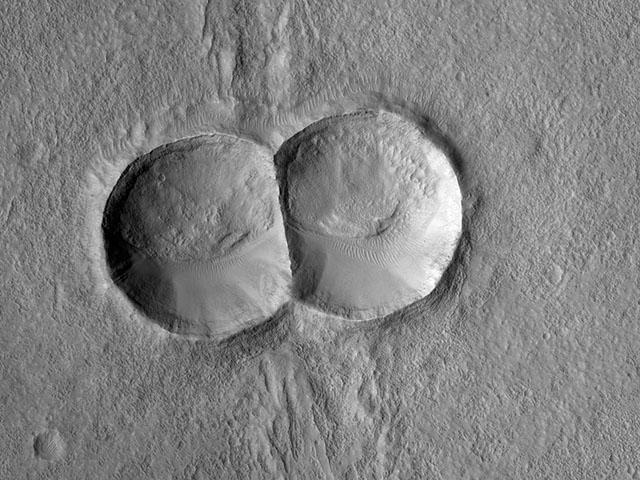
Image by NASA/JPL/University of Arizona
Double Craters
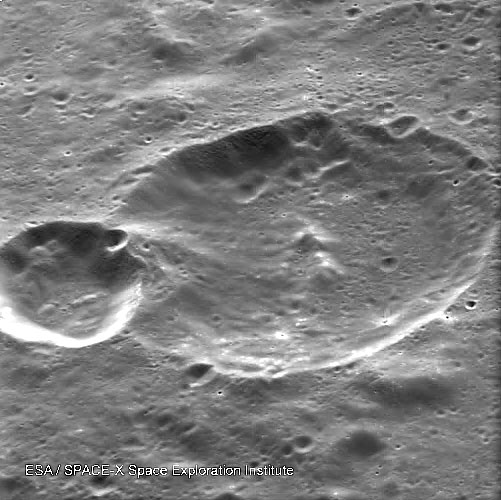 Image by ESA/Space-X under CC BY-SA 3.0 license |
This left image shows what we would more or less expect to see in a double crater formation. In this double crater you can clearly see that the large impact happened before the smaller impact, because the smaller crater forms a full circle. The line in between the two craters is now bend towards the larger crater hole. These two impacts might have happened many years apart from one another, but even when the impacts happen almost simultaneously, one would still expect either a crater formation like the one in the left image, or one whose center line is more chaotic / less well defined. After seeing both these images, one with a straight line and one that does not have a straight line in between the two craters, it is still a legitimate thought that the first photo showed a double crater with a perfect straight line because it was a one in a million shot, a pure coincidence. But one can easily come to the conclusion that it is not a coincidence just by looking at the rest of the surface of Mars, the moon or other planets. |
Of the next four images below three were taken on Mars, one (lower right) was taken on Ceres (dwarf planet). All these images show double crater formations with a straight line in between the two craters. These images show that the straight line in between a double crater formation is not a coincidence. One of the images, at the upper right, even shows a triple crater formation seperated by two straight lines, which is a definite proof that each straight line is not a one in a million shot.
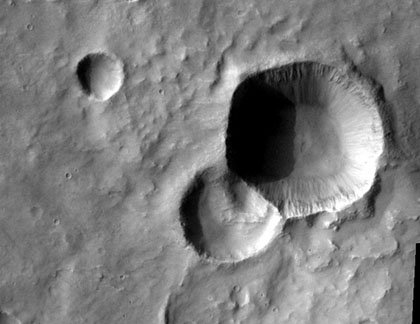 Image by NASA/JPL/Caltech/ASU |
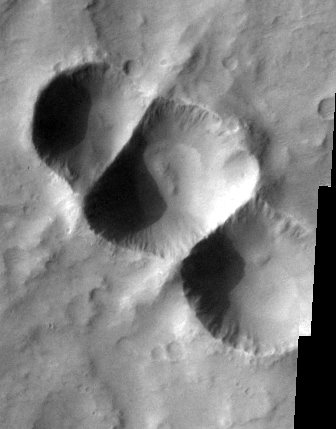 Image by Nasa/JPL/University of Arizona |
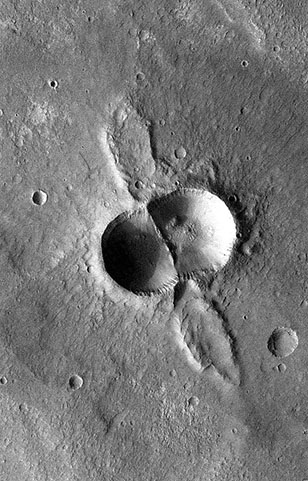 Image by NASA/JPL/Caltech/ASU |
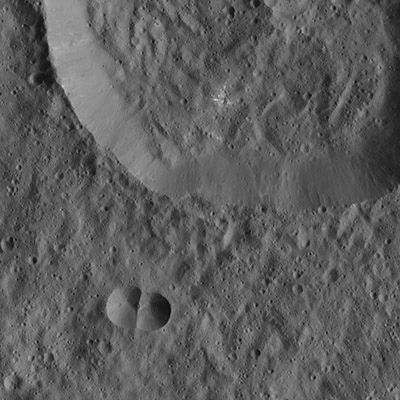 Image by NASA/JPL/Caltech |
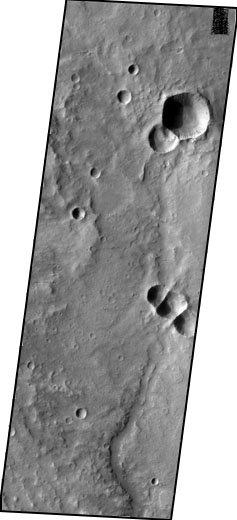 What makes it even more convincing is that two of these images were taken within the same surface area of Mars not very far apart from one another, which is shown in the image on the right. Only by looking at these four images one can come to the conclusion that a multiple crater formation separated by straight lines, which should be very rare based on our basic presumptions of the dynamics of surface impacts, is actually quite common.
What makes it even more convincing is that two of these images were taken within the same surface area of Mars not very far apart from one another, which is shown in the image on the right. Only by looking at these four images one can come to the conclusion that a multiple crater formation separated by straight lines, which should be very rare based on our basic presumptions of the dynamics of surface impacts, is actually quite common.
Most double craters are not separated by straight lines, which is probably due to the fact that the two impacts did not occur simultaneously. They either happened a short moment apart, or they might have been formed years apart from one another. But if we take into consideration the probability that the craters with the straight lines are caused by simultaneous explosions, then our normal understanding about thermal explosions does not explain the straight line either.
If we attempt to reproduce these double craters within laboratory tests, using common thermal explosions, then we will soon find that the straight line is impossible to reproduce. But there has to be some kind of energy release that can form that straight line without even a high number of attempts. This type of energy release should form the two round intersecting crater holes with a shared outer wall in between the two craters as a straight line. To find out more about the origin and the dynamics of this release of energy we need to look at more clues that these Martian and other planetary craters provide us with.
Are Craters Created by the Force of an Impact?
To find one useful clue we take a look at the overall shape of a single crater formation. Most craters are round, their shape comes close to being a perfect circle. The odd thing about this is that most meteors do not fall straight down from the sky, instead they approach the surface at an angle. The round shape of a crater is what we would expect if the meteor falls straight down from the sky, at an 90 degree angle in respect to the orientation of the ground surface. Because a meteor in most cases descends towards the ground at a lower angle than 90 degree while performing a flight over the terrain in one particular direction, we would expect the direction of the impact to somehow influence the shape of the crater that is formed when the meteor hits the ground. Despite the direction of the impact the shape of the crater is in most cases round.
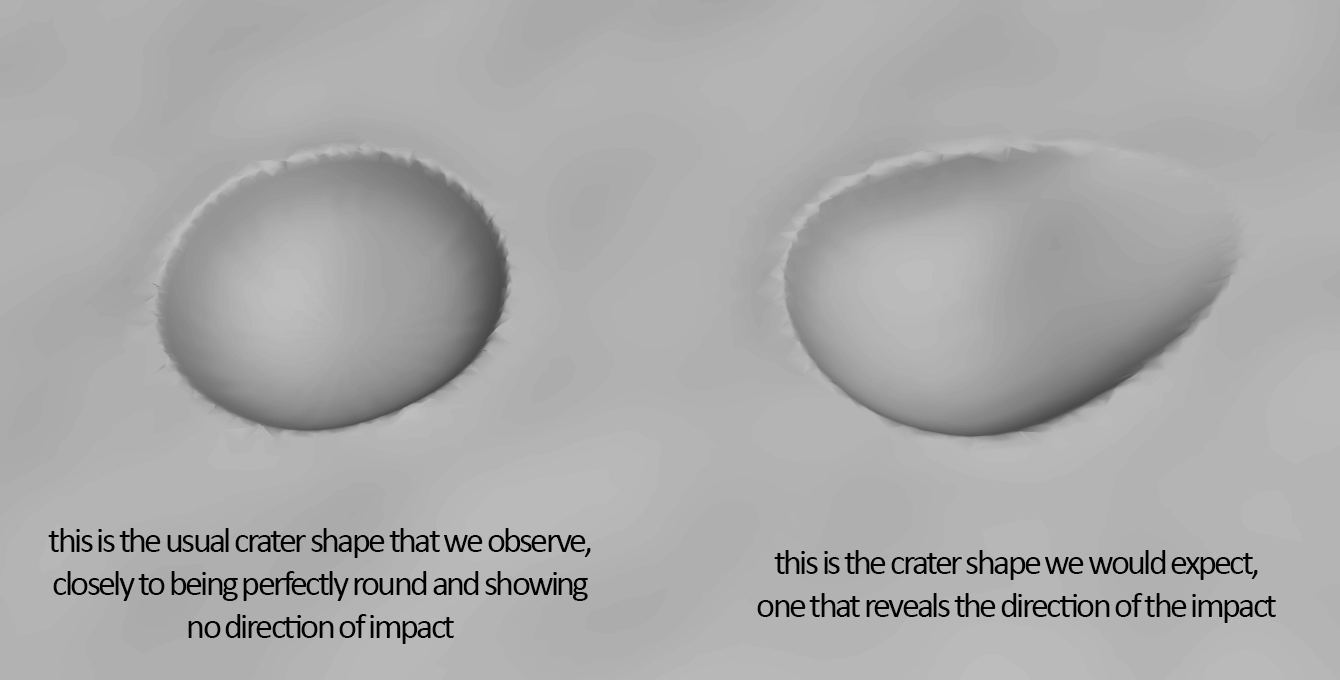
This reveals to us that the shape of the crater is not formed by the mass of the object that collides with the surface. It is not formed directly by the kinetic energy of the meteor, thus the energy of an object at it possesses due to its motion.
So the next possibility to explore is to consider whether the crater is formed by some kind of energy release, either an explosion or something else than an explosion, but one that can explain both the shape of a single crater, and the shape of the straight line in between a double crater formation.
Spherical High Energy Bursts
Because the craters have a round shape, we need to look for a type of energy release that is round in shape, and one that hopefully also explains why the direction of the meteor does not influence the shape of the crater formation. One type of high energy spherical explosions can be found in some nuclear detonations. In some nuclear detonations a spherical dome forms shortly after the formation of the mushroom cloud. This spherical dome is larger than the mushroom cloud itself and covers the entire mushroom cloud. This spherical dome however is not part of the shockwave that forms due to the explosion. While the shockwave progresses outward from the center of the explosion, the spherical dome remains static on the same position with a fixed radius. The dome does not expand or contract but it does disappear after existing only a couple of seconds.
Only the nuclear detonations that are most energetic show this spherical dome that forms around the mushroom cloud. In weaker explosions the spherical dome only nearly forms or not at all. In non-nuclear explosions it is very rare to witness a spherical dome.
 |
 |
The nuclear dome is a spherical vortex type, thus an orb (keep in mind that an orb is not a vortex type, nor a vortex class, instead an orb belongs to a collection of vortices that can belong to different types and classes). This spherical vortex type might explain how the craters are formed by meteor impacts. Particularly because of their characteristic of not expanding or contracting during the explosion, this might very well provide a clear explanation for the straight line forming between a double crater formation. However, this particular dome shape that forms at nuclear detonations is hollow, it is not that energetic in its interior to be able to form a crater. Nuclear detonations can form craters but their radius is much smaller, closer to the center of the explosion, not well-defined with a steep outer wall as a moon-crater and not formed by the spherical dome. The type of energy outburst that causes the creation of a crater is not the same kind of energy output as we see in the upper two photographs of the two nuclear detonations, but we might be closer to identifying the correct type of energy output and the correct type of vortex because of the reason that these nuclear domes do explain a few factors that were unexplainable until this point.
If we look at actual footage of a meteor impact here on earth, like the Russian meteor in the video above, then we see a huge flash of light that takes place not on the ground but above the ground. A meteor in many cases never actually reaches the ground, craters might be formed by the explosion that takes place above the ground than the actual impact. In this example the shape of the flash of light does suggest that the energy output might be spherical, yet this is not certain at this point.
_UnderCC01.0.jpg) The flash of light is also a type of light that looks very similar in vividness and intensity to the type of light formed by a welding tool. This suggests that the release of energy might have an electrical cause. Arc welding is a process that is used to join metal to metal by using electricity to create enough heat to melt metal. It is a type of welding that uses a power supply, either direct (DC) or alternating (AC) current, to create an electric arc between an electrode and the base material. The possible existence of a high electrical charge within the incoming meteor might also explain the fact that meteors have been observed to explode above ground level.
The flash of light is also a type of light that looks very similar in vividness and intensity to the type of light formed by a welding tool. This suggests that the release of energy might have an electrical cause. Arc welding is a process that is used to join metal to metal by using electricity to create enough heat to melt metal. It is a type of welding that uses a power supply, either direct (DC) or alternating (AC) current, to create an electric arc between an electrode and the base material. The possible existence of a high electrical charge within the incoming meteor might also explain the fact that meteors have been observed to explode above ground level.
The theory that craters might have been formed by electrical discharges is not new. This has been suggested or proposed before by Wallace Thornhill, Brian J. Ford, C. J. Ransom, Barry Setterfield, Zane Parker, James St. Pe and others.
Double Craters and Double Orbs
The best possible explanation for the formation of the straight line in between a double crater is found in one particular spherical non-rotational vortex type, the bubble. When two soap bubbles connect both bubbles form a little over 2/3 of their volume, the connection between the two bubbles cuts away less than 1/3 of their volume. This is the same observation that we make when we look at the craters on Mars or on Ceres. This is a strong hint that those craters are formed by some sort of spherical orb-like vortex movement. Not just bubbles, but also orbs of other types exhibit the same tendency to connect in that similar manner.
|
Image from maxpixel.freegreatpicture.com |
_UnderCC01.0.jpg) Image by Meim (Pixabay) |
What is also matching with the shape of craters is the connection between the two bubbles. The wall that connects the two bubbles is a thin membrane that is completely flat, looking at it from its side it forms a straight line. If the two bubbles are connected to the ground then the footprint of that wall on the ground is a straight line. The only factor that does not match with the craters is that the soap bubbles that connect to the ground are formed a little over 50% of their volume, while craters appear to be formed by far less than 50% of a full sphere. This difference could be caused by the meteor exploding at some distance above ground level and not when colliding on the ground.

What we can learn from comparing the soap bubbles with the double craters is that the energy release of the incoming meteors forms a spherical non-rotational vortex type that behaves similarly to the soap bubbles in the way that the bubbles connect. It is therefore very likely that craters are indeed formed by a quick energy burst that forms one orb, or in some cases more than one orb simultaneously.
The characteristic of some orb types to maintain a fixed radius without expanding or contracting for at least a short moment of time and the manner in which two orbs are able to connect while being separated by a flat, straight wall is the only way that the straight line in between a double crater can be explained. The fixed radius of some orb types, such as the ones observed at nuclear detonations, also explains the always round shape of nearly all craters.
Double Ring Craters
Now look at the two large craters on the Martian surface in the image below. Both craters have a smaller crater inside them, at the exact center. One would think that a crater within a crater is just a consequence as a result of the way that the meteors fell from the sky. In that scenario most likely the larger crater formed first, and the smaller hit the center of the larger crater at a later time. But these are two craters... both with a smaller crater at the center... both at the exact center. This one image alone already suggests that something out of the ordinary has happened here.
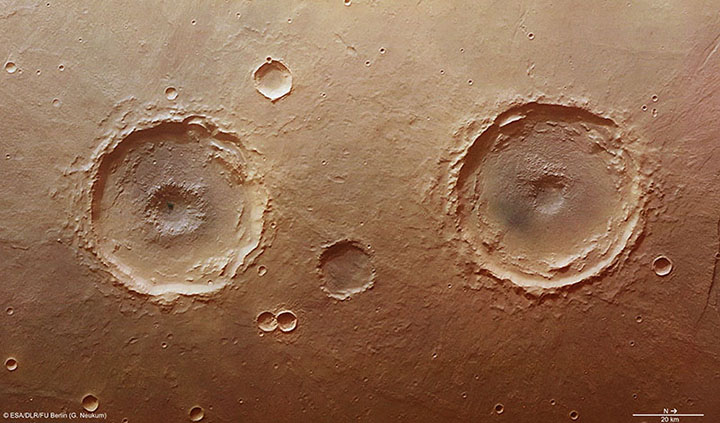
Image by ESA/DLR/FU Berlin
If we explore the surface of Mars and other moons and planets for more clues we quickly find many, many craters with a second crater within the first crater that is almost or exactly positioned at the center. We also find some double ring craters where the smaller crater is not at all positioned at the center of the larger crater, but there are too many of these double ring craters where the smaller crater is at the exact center to be able to allow us to assume that these formations are pure coincidence. The craters where the smaller crater is not at the center are the craters that are formed by pure coincidence by the random locations of impact that happened years apart from one another, for the craters where the smaller crater is at the exact center we need to find the missing explanation.
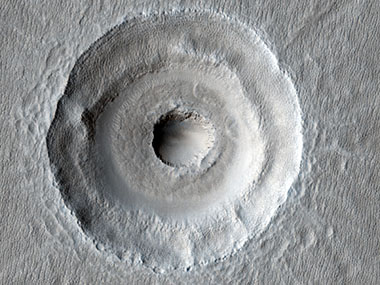 Image by NASA/JPL-Caltech/University of Arizona |
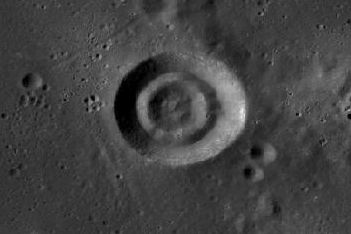 Image from wikispaces under CC BY-ND 3.0 license |
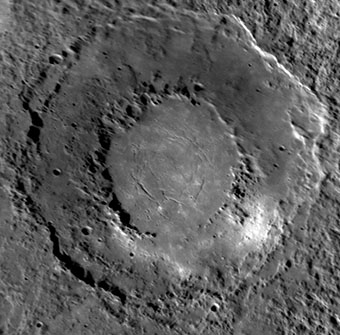 Image by NASA/Johns Hopkins University/ Carnegie Institute Of Washington |
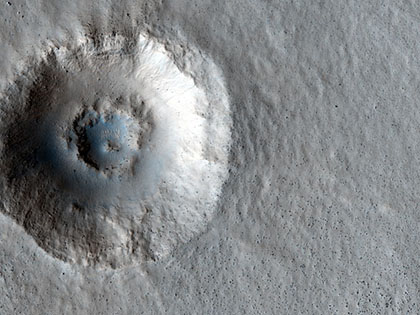 Image by NASA/JPL-Caltech/University of Arizona |
If we take into consideration that what we have just learned about the type of vortex movement that is initiated when a meteor explodes, namely that the release of energy creates one or more orbs, spherical vortices, then it does not take long to find a good explanation. By looking at one other phenomenon that is caused by orbs, which is sun halos, we find that same orb within the larger orb, at the exact center. A double halo shows this same composition, along with a double Einstein ring (gravitational lens system SDSSJ0946+1006) that can be found in outer space.
_PublicDomain.jpg)
A better example of orbs within orbs with different densities is the structure of our sun. The sun has a convective zone, a radiative zone and a core. All three of these spherical regions take in a large volume of our sun. Each of these zones has a smaller radius than the previous one and all these zones have different temperatures. If a plasma orb whose structure includes two or three of such regions is what creates the double ring craters then a denser orb within a larger less denser orb could be the cause of a crater within a crater. It is worth to explore this possibility.
 |
_Edited_PublicDomain.jpg) |
If the meteor explodes above ground level then it is possible for the radius of the outer orb to match with the radius of the crater, but then the inner orb is too high to be able to form the inner smaller crater. In the illustration we are forced to move the orb to a lower position, all the way to the point that it explodes at ground level, to position both the inner and outer orb in a way that it is quite possible for them to create the large and smaller crater. However, both orbs are now larger than both craters. Although it seems plausible for a large orb to create a smaller crater, it does not seem plausible that such a crater would then still have sharp outer edges. For that to happen the radius of the orb should match the radius of the crater along the edges. But if we change the radius of the outer orb and inner orb to match the radius of the outer crater and inner crater, then the inner orb can no longer overlap the location of the inner crater, for the crater is too low positioned in the deep crater.

This is obviously not satisfactory, yet there's still a possibility that the orb-within-orb explanation for the double ring craters might be viable, for that we need to take into account that most craters observed on various terrestrial bodies are not very deeply rounded, instead most craters are more shallow.

With a more shallow crater it is possible to match both the outer orb and the inner orb with the large crater and the smaller crater at its center. Both radii also match with the radii of the edge of the craters so that the formation of a sharp edge becomes explainable. Now we do have one viable explanation for the geometry of the crater that matches with all the requirements.
But this is not where our search for a matching explanation ends. It is generally believed that double ring craters are caused by not differences in density within the plasma volume of the explosion but instead in differences in density of the target ground material. This could happen when a stronger material overlies a weaker material. This too is a possibility worth to explore. We now only need a single orb to explain the shape of the crater, and we take into consideration that the ground could consist of different layers at different depths with different densities.

Here we can also reduce the radius of the orb so that it matches with the radius of the edge of the large crater, because we don't need to match the position of an inner orb. For the smaller crater to be able to form, in the less denser depths of the ground, the radius of the orb still has to exceed the depth of the crater, but that is still a plausible method how the crater is formed. This smaller crater can also have sharp outer edges because the ground at the edges is more dense than the ground underneath. So now we do have two viable explanations for the geometry of the crater that matches with all the requirements. Yet with this second explanation it is possible for a crater to be deeply rounded, while with the first explanation this is not possible. But... with the first explanation it is also possible to create a small inverted crater within a large crater, a bulbous mountain, which should be possible when the inner orb has a lower density than the outer orb.
Crater Chains
Here we discuss another strange crater phenomenon that needs an explanation. A crater chain, also known as a catena, is a line of craters along the surface of a moon, planet or comet. This is yet another crater phenomenon that has been observed multiple times on several astronomical bodies such as the moon, Mars, Ceres, and moons of Jupiter, Saturn and Neptune.
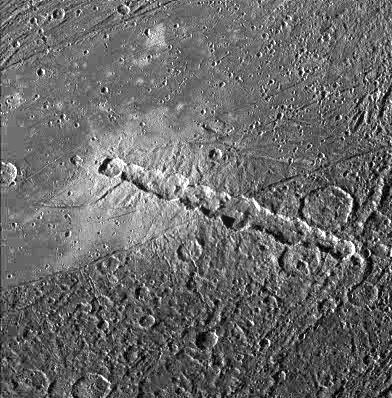 Image by Galileo Project/Brown University/JPL/NASA |
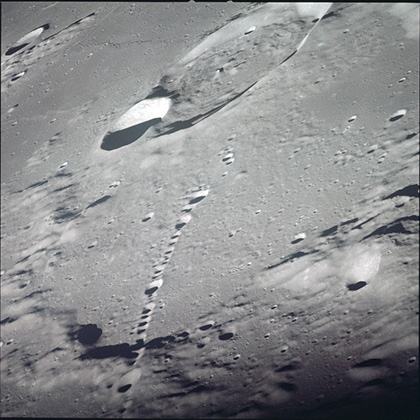 Image by NASA |
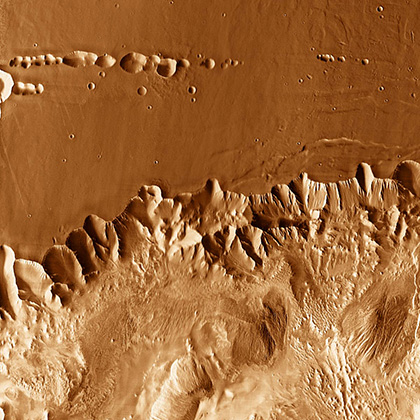 Image by NASA/JPL/University Of Arizona |
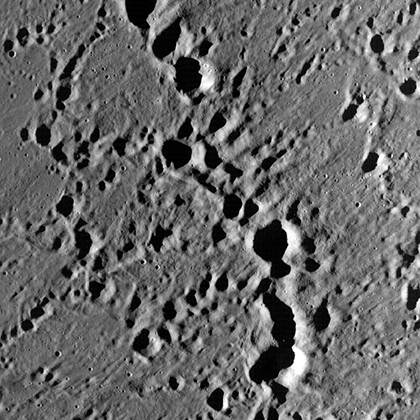 Image by NASA |
It is thought that these crater chains are formed when a fragmented comet hits the surface of a planet whereby its separated pieces form a row of craters on the surface of the moon or planet. But there is something illogical about this assumption, namely that it is quite impossible for the impacts to create a row of craters that form a line unless the row of craters is also spread out somewhat in width. The shape of the area in which the craters are distributed should be oval shaped if the observations should fit adequately with the theory, but it does not. These are clearly lines / rows of craters.
It does not make a difference if the meteor breaks apart its pieces keep drifting apart from one another before they hit the ground or if the meteor breaks apart, the pieces each take in their own position close to one another and then continue heading in identical direction towards the ground. Both these scenarios distribute the impacts within an oval shaped surface area. The only difference between these two scenarios is that the first fragmentation-method spreads over a larger surface area than the second one.
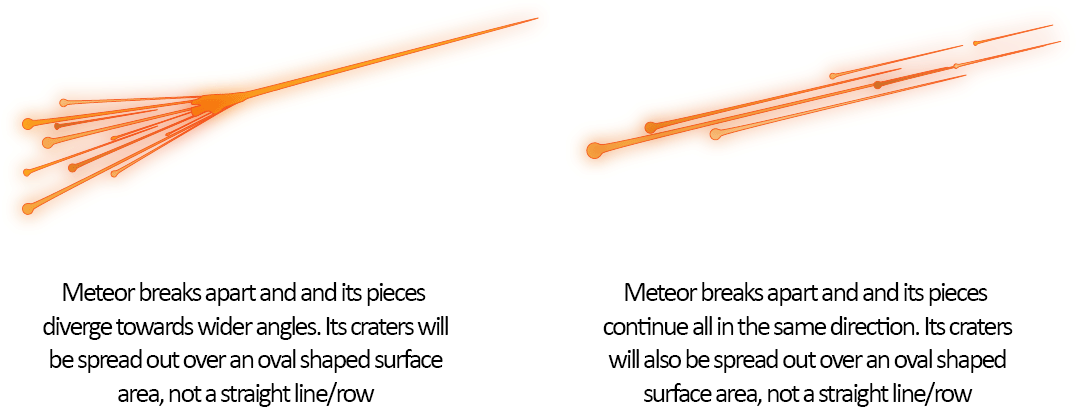
One scenario that can explain the rows of craters on the surface of moons and planets is one in which all craters that form one row are created by only one fragment, thus only one meteor. And the reason that that one meteor can create multiple craters is because it has the ability to bounce. It could very well be that it is the plasma orb that surrounds the meteor that can bounce (and even roll) on the surface of the planet, and along with it the entire meteor can bounce as well. In that case the meteor never physically hits the ground up until the very last impact and the very last crater at the end of the row is formed. And even at that last impact it might just explode above the ground and disintegrate completely before anything of it can ever reach the ground surface. The radius of the plasma orb that surrounds the meteor is much larger than the radius of the actual meteor (this is clearly observable in the video of the falling Russian meteor found further up in this page).
The video below demonstrates how a ball of plasma can bounce several times on a hard surface floor and how the ball of plasma can easily bounce in a straight line. Although the video's title mentions ball lightning, it not ball lightning what we are looking at. Ball lightning is a phenomenon that people have been searching for for several centuries in an attempt to be able to identity and study it, but it has still not been identified or confirmed. But it could be that the same type of plasma balls that we see in this video were responsible for some of the reported sightings of ball-lighting in the past history. There is also the possibility that we are looking at a phenomenon whose characteristics are in some way comparable to those of ball-lightning, if ball-lightning exists. These little balls of plasma have a fuel source at its center, a physical material. The meteor plasma-orb also has a fuel source at its center, in that case it is the meteor itself that is the fuel source for the plasma-orb.
Friction
One important answer we need to look for is why the bolides, the intense balls of plasma, start to form above the ground when the meteors descend to earth and not on the ground at impact. One of the possible causes could be friction with the air, or drag. To evaluate if the formation of the bolide can be caused by friction we take a look at a very old example of how fire was made. We take a closer look at a flint and steel. The video below shows a slow motion closeup of a flint and steel in action.
The video shows how balls of plasma quite similar to the ones we saw earlier bouncing around on the floor in the previous video are also evident when we strike together a flint and steel. A flint and steel creates a spark through friction. This strongly suggests that the bolides that are observed at meteor impacts on earth could also be caused by friction, namely friction with the air in the earth's atmosphere. Because the meteors move at the speed of kilometers per second, such friction with our atmosphere, which gets denser as the meteor descends towards the earth, can generate a high amount of heat despite that it is only a gas colliding with a solid.
However, although this can explain how the bolides are formed when comets enter our earth's atmosphere, it does not explain how bolides can be formed when they approach the moon's surface, where there's virtually no atmosphere. The moon's atmosphere consists of a thin layer of widely dispersed gasses and is therefore almost similar to a vacuum. It is so thin that it can not generate enough friction to produce high levels of heat before the meteor reaches the surface.
 Secondly, although these miniature bolides are quite intense, they are not nearly intense enough to be of the same intensity as the bolides that would blast a crater hole into a planet's surface. These small balls of plasma do not noticeably affect any material unless the material has a very low density or is very flammable. Even soft materials remain unaffected by these plasma balls since they simply bounce off them after impact. These miniature plasma balls are not certain to be the same phenomenon that creates the meteoride bolides.
Secondly, although these miniature bolides are quite intense, they are not nearly intense enough to be of the same intensity as the bolides that would blast a crater hole into a planet's surface. These small balls of plasma do not noticeably affect any material unless the material has a very low density or is very flammable. Even soft materials remain unaffected by these plasma balls since they simply bounce off them after impact. These miniature plasma balls are not certain to be the same phenomenon that creates the meteoride bolides.
These miniature balls of plasma show visual similarities to the electrical arc of a welding tool, and look identical to the plasma balls that are sometimes ejected from a welding tool when it is in contact with materials. Although the welding tool is an electrical device that spawns an electrical arc, the sparks of a flint and steel are not electric in any way as far as we know. If they would have been electric in the form of lightning, then their heat and ability to inflict damage could be greater.
Speed and Compression
A fire piston is a tool that is used to make fire, function-wise it belongs in the same category as a flint and steel. A small piece of highly flammable material, such as a cotton ball or dry grass, is placed at the bottom of a closed narrow cylinder. A piston with an air-tight seal is slammed into the cylinder which will cause rapid compression of the air within the cylinder, thereby temporarily raising the temperature within the chamber to above 260 °C (400 °F). If done effectively this short sharp rise in temperature will ignite the flammable material. It is a simple crafted tool used in ancient times.
There are a few similarities between the mechanism of the fire piston and the heat produced at a falling meteor. Both require high speeds, both movements produce a great increase in pressure by compression of air, and both initially start with the same shape of vortex movement. The most significant difference between the two is that only the falling meteor produces the bright white light. We will take a look at both phenomena, and try to understand and explain what the mechanisms are that produce the effects that are observed with these two phenomena.
Before you read what comes next it is best if you have read most of the theory on the science pages of this website, and at foremost the page about inversion. On the page about inversion it is explained what a fallback is. It is also assumed that you know what the zero point is as explained by the theory on this website.
The high increase in air pressure right in front of the falling meteor will cause an inversion followed by a fallback (instant release of pressure) to the equilibrium when the total compression has reached a certain high level. There are different types of fallbacks with different types of vortices associated with them. The image below shows four types of vortices that can be produced with an increasing level of compression. The level 3 fallback is the vortex produced with the lowest amount of compression, the level -1 fallback is the vortex produced with the highest amount of compression. In between the start location (the low end of the vortex) of the level -1 fallback and the level 1 fallback is the zero point from which light originates.
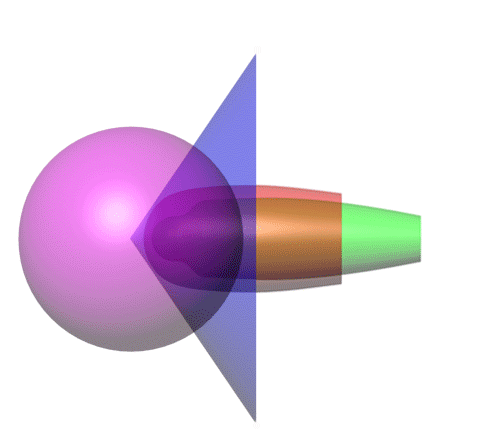
_UnderCCBY4.0.jpg) The level 3 fallback does most likely not take form when a meteor descends within the earth's atmosphere. The fallbacks most likely start at level 2 and then if there's sufficient speed and sufficient increase in compression the fallback will progression to a level 1, level 0 and then a level -1. A bullet travels at speeds at around approximately one kilometer per second, which is insufficient for the bullet to emit light. The movement of the bullet can never hit the zero point. A meteor enters our atmosphere at speeds over 10 km/sec, which enables the movement to hit and surpass the zero point, and thereby emitting light that originates from the zero point.
The level 3 fallback does most likely not take form when a meteor descends within the earth's atmosphere. The fallbacks most likely start at level 2 and then if there's sufficient speed and sufficient increase in compression the fallback will progression to a level 1, level 0 and then a level -1. A bullet travels at speeds at around approximately one kilometer per second, which is insufficient for the bullet to emit light. The movement of the bullet can never hit the zero point. A meteor enters our atmosphere at speeds over 10 km/sec, which enables the movement to hit and surpass the zero point, and thereby emitting light that originates from the zero point.
The fallback within the fire piston is always a level 2 fallback, no matter how far the piston has plunged into the cylinder. This is because the fallback can not expand outwards and its type is defined by the shape of the device. For this reason the movement does not reach the zero point and no light is observed until the material starts burning. Although it is only a very short moment, a fraction of a second, we should at least see a short flash of light when the piston reaches the deepest point if the zero point was hit, which we do not see. Also, the speed of the piston is nowhere near the speeds of above 10 km/sec. It is not possible for anyone to move their hand that quickly.
I say that the speed is nowhere near above 10 km/sec with a bit of doubt. There is a very thin layer of air escaping through the sides of the piston in the opposite direction to the movement of the piston at a much faster speed than the movement of the hand. The thinner this layer is, the higher the velocity of the air that escapes through it.
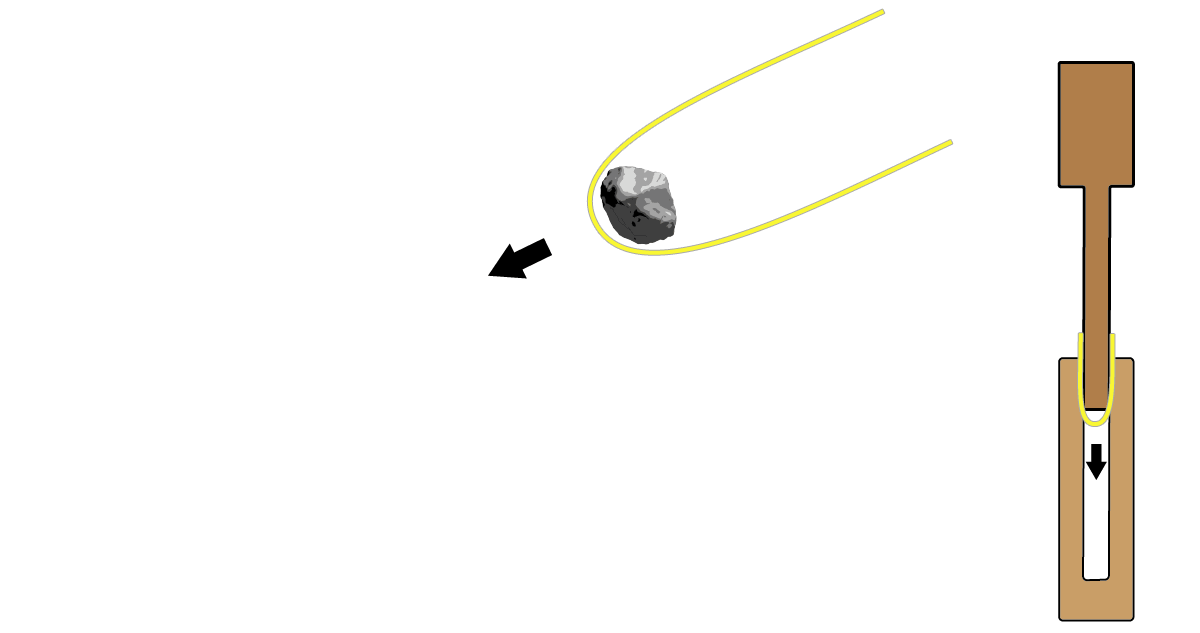
At the meteor the fallback does progress from a level 2 fallback at high altitudes to a lower level fallback at lower altitudes, where the air is thicker and there's more friction. The movement even surpasses the zero point if the speed of the meteor is great enough at low altitudes, from that point on the meteor starts to emit a very bright light. As the meteor becomes brighter its tail rapidly becomes shorter and fades out. The question is what exactly the nature of this bolide vortex is. Because the fallback takes place beyond the zero point, thus within the negative dimensions (level -1) instead of the positive dimensions as with the other 3 fallbacks, it is not clear to where the movement jumps to. Until now it was believed that such a movement would cause an explosion, but it is clear from how the craters are formed that they are formed by a spherical shape that has a fixed shape and size for at least a moment, it does not expand like an explosion does.
The fire piston is not known to produce an electric discharge. The fire piston might only produce heat, not electricity. It might be that the fire piston does produce an electric discharge which should only persist for a small fraction of a second and therefore is difficult to detect, but it is more likely that the movement does not cross the zero point and thus does never cause the same physical phenomena that the meteor bolide does. Thus even when it is certain that no electric discharge takes place at the bottom of the fire piston, it still does not explain us the nature of the bolide vortex. With this lack of information we should thus hope to find a different phenomenon which we can compare with the phenomena observed with the meteor bolide, one that provides us the remaining puzzle pieces or different puzzle pieces.
Piezoluminescence
To be able to find more puzzle pieces that might explain to us whether a meteor bolide produces an electric discharge we try to look at again a different light phenomenon. Piezoluminescence is a phenomenon at which light is generated by a crystal when that crystal is put under pressure by an external force. For this force to be able to cause the crystal to emit light the force needs to be dynamic and not static. This light is emitted when the material starts to crack internally as a result of the dynamic force.
An interesting fact about this phenomenon is that piezoluminescence also produces electricity, but it does not produce heat. This is called piezoelectricity. There are at least three similarities to be found between the phenomena observed with these crystals and the phenomena observed with the falling meteor. First is that both situations involve a dense low dimensional material, for one this is rock, for the other this is crystal. Second similarity is that both involve a high amount of pressure. And the third similarity, which might not be that obvious at first, is that both situations involve tremendous speeds.
Crystal is a very low dimensional material, the more low dimensional a material is, the faster a vortex moves that is formed by that material as its medium. The cracks that appear within the material are a result of the very fast vortex movement that takes place within the crystal, which takes place at speeds seemingly similar to the speed of lightning. Initially when the crystal is put under a lower pressure no light is emitted and also no movement within the crystal takes place. It appears at first that no vortex movement can take place within a material as hard and dense as a quartz crystal. This misconception is caused by another property of low dimensionality, which is insensitivity. Insensitivity means that the material does not easily react to an external force, but once the external force has exceeded a certain high level, the material will start to move, and it will do so at extreme speeds because of its very low dimensionality.
Piezoluminescence shows how high pressure can cause both light and electricity with very little requirements. All it takes is one particular dense material and one external force. With this in mind, piezoluminescence could have been a phenomenon that suggests a falling meteor could produce electricity also by using high pressure to create electricity. But if that was so then piezoluminescence should also cause heat, which it does not. For this scenario to be similar to the falling meteor both light and heat need to be present.
It could however be that the light and heat from the falling meteor do not originate from the same location than was previously assumed. It could perhaps be that the heat originates from the external front area of the meteor, and the light (and thus possibly also the electricity) originates from the internal volume of the meteor. If that is so then both situations (falling meteor and piezoluminescence)could be similar. The drill in the example video does generate heat on the outer surface of the crystal. Piezoluminescence however does appear to require a material that is either transparent or translucent to be able to emit any form of light from its interior. There are no known confirmed observations of piezoluminescence in which light is emitted from a non-transparent and non-translucent material, at least not yet. But... we should not forget the possibility that the meteor material might be transparent or translucent, which could be the case if the meteor consists entirely of ice, or if it consists partly of ice by carrying a layer of ice on its outer surface. If that ice has solidified within the vacuum of outer space, for example after moving away from a star, then the ice will have tension in it after moving from the vacuum into our atmosphere. The release of that tension can cause an electric discharge, such as the natural lightning we observe within our atmosphere, which is also caused by the sudden release of tension. Ice is a material that can exhibit luminescence. Even by removing ice from a freezer in a darkened room, under conditions in which the ice makes cracking sounds from sudden thermal expansion, the ice can exhibit luminescence in the form of flashes of white light. The only inconsistency here is that atmospheric lightning causes tremendous heat, and piezoluminescence does not. It is to be expected that the very high temperatures are a requirement for the craters to be able to be formed.
If there is a build-up of an electric charge within the meteor and there is no direct relation between the build-up of pressure and the moment of the discharge explosion, then the moment of detonation could be determined by the approach of the electric field of the planet or moon. This could explain how craters are formed on the moon, where there's virtually no atmosphere and where it is expected that little pressure can build up in front of the meteor before it impacts with the moon's surface. The other possible explanation would be that the meteor makes a physical impact with the moon's surface instead of exploding/discharging above ground level. The explosions above ground level have been observed and confirmed here on earth, but not on the moon. If such a highly electrically charged meteor detonates at impact with the ground then this would explain why the direction of the impact can not be seen in the shape of the crater despite the actual physical impact, since it is not the forces of the impact that determine the shape of the crater but instead the forces that result from the sudden discharge are what form the crater. The impact would then only act as a detonator.
There is also the possibility that the meteor does not contain a transparent or translucent material and that the meteor rock does produce piezoelectricity, but no piezoluminescence. It could then be possible that the piezoelectric effect builds up an electric charge within the meteor, which creates an electric discharge explosion on the actual impact with the ground or above ground level when the pressure exceeds the maximum tolerable level. But then the question would be, what produces the light? For this scenario to be correct we again need to split the effects into separate phenomena with separate causes, which makes this possibility less likely to be the correct one.
Conclusion
If it is correct that the craters are formed by an extremely high temperature plasma orb, then it is not certain that the plasma orb has an electrical nature. Plasma does not necessarily mean electricity. Still, if we look at all the natural phenomena here on earth that produce high temperatures, then the only phenomenon that can reach anywhere near these extreme high temperatures is lightning. This does make the probability of an electrical discharge as the possible correct explanation very high. But despite that these temperatures have been confirmed with lightning, this same natural phenomenon has never been observed to alter the terrain at a large scale. The only confirmed existing effect of atmospheric lightning on the ground terrain are fulgurites, formed by the impact of lightning in sand, which are most of the times smaller than a meter in length.
If we look at all the man-made electrical devices then we do find those that can alter dense materials. The electrical arc produced by a welding tool is still a good example of this. But despite that on this page it has been attempted to search for many possible puzzle pieces and tried to link the correct pieces together, there is no confirmation yet of any phenomenon that meets all the requirements to confirm that the energy outburst from a falling meteor is similar to the electrical arc from a welding tool. The sparks from a flint and steel do not affect even soft materials, the fire piston does not appear to produce an electrical discharge, and piezoelectricity does not produce heat. But despite these dead ends within this quest for answers it does appear the answers are getting closer. One or more of these attempted links should bring us in the right direction eventually.
Finally I would like to remind again that the idea that crater formations on terrestrial bodies might have an electrical cause is not something new. This has already been proposed by the Electric Universe Theory for many years. According to the Electric Universe proponents, both craters and comets are believed to have an electrical nature, although it is not proposed that all craters are created by comets (meteoroids are smaller versions or fragments of comets, which are called meteors as soon as they're entering a planet's atmosphere). It is believed that some craters are formed by electrical scarring from interplanetary discharges (called super-lightning). This is described as electric discharges between closely approaching bodies which is said to orginate from electromagnetic structures called 'plasmoids'. Many interesting ideas, thought-provoking experiments, and new approaches to scientific mysteries can be found on the Electric Universe website or the Thunderbolts Project Youtube channel.
The conclusion I can give is that this is an exciting time for science. There are many scientific revelations lying around the corner. There are many old mysteries that are about to be solved within the coming decades. It might be that some of these revelations will confirm that what we had expected in the past years, it might also be that many of us will for some part need to adjust our ways of how we perceive the universe. Either way we should look at these discoveries as positive accomplishments that should be used to bring humanity closer together by forming a strong general consensus on the basis of proven scientific facts. The road to the future won't be one that will not nourish our science-oriented minds.
| All content on this site that is authored by Peter.A.Venis is licensed under the Creative Commons CC BY 4.0 license, unless otherwise mentioned. Most pages on this website also include material from other authors, under different licenses. Both the author's names and the licenses are mentioned in the file names whenever this information is known and can be provided. The presence of work from other authors on this website does not necessarily imply that those authors endorse the contents of this website. |
| A word that is often used on this website is the word 'vortex'. Many sources describe a vortex as a movement in a fluid that has a rotational flow. Yet many of the vortices that I describe on this website do not show a visible rotational flow. I took the liberty of using the word vortex for describing a phenomenon that had not been understood before, one that links together rotational and non-rotational movements. Even a movement in a straight line can in some cases be categorized as a vortex, if it is known that that movement is created by certain identical conditions. So keep in mind that the word 'vortex', within the context of the infinity-theory, has not the exact same meaning as other sources describe. |




